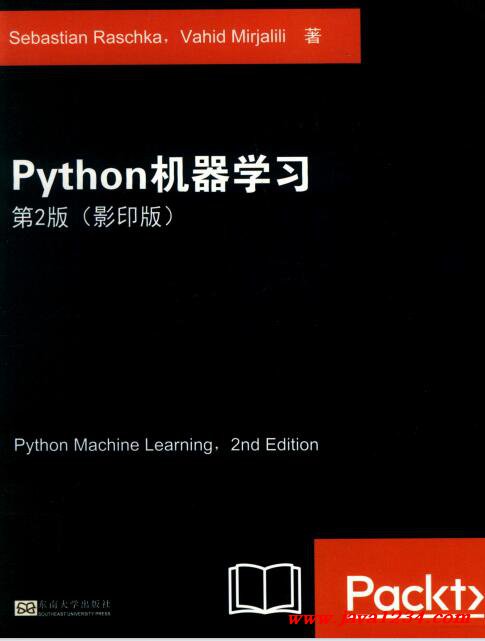| 澶辨晥閾炬帴澶勭悊 |
|
Python鏈哄櫒瀛︿範(fàn) 絎?鐗?(褰卞嵃鐗? PDF 涓嬭澆
杞澆鑷細(xì)
http://www.python222.com/article/942
鐢ㄦ埛涓嬭澆璇存槑錛?/strong>
鐢?shù)瀛愮増浠呬緵棰勮锛屼笅铦插?4灝忔椂鍐呭姟蹇呭垹闄わ紝鏀寔姝g増錛屽枩嬈㈢殑璇瘋喘涔版鐗堜功綾嶏細(xì)
https://product.dangdang.com/11193811525.html
鐩稿叧鎴浘錛?br />  璧勬枡綆€浠嬶細(xì) 鏈哄櫒瀛︿範(fàn)姝e湪铓曢杞歡涓栫晫銆傚湪榪欐湰Sebastian Raschka鐨勭晠閿€涔︺€奝ython鏈哄櫒瀛︿範(fàn)錛堢浜岀増錛夈€嬩腑錛屼綘灝嗕簡瑙e茍瀛︿範(fàn)鍒版満鍣ㄥ涔?fàn)銆佺緇忕綉緇滃拰娣卞害瀛︿範(fàn)鐨?鍓嶆部鐭ヨ瘑銆?濉炲反鏂拏瀹?middot;鎷夋柦鍗°€佺摝甯屽痙·楹﹀姞鍒╁埄钁楃殑銆奝ython鏈哄櫒瀛︿範(fàn)銆?鏂板茍鎵╁睍浜嗗寘鎷瑂cikit-learn銆並eras銆乀ensorFlow鍦ㄥ唴鐨?寮€婧愭妧鏈€備功涓彁渚涗簡浣跨敤Python鍒涘緩鏈夋晥鐨勬満鍣ㄥ涔?fàn)鍜屾繁搴﹀涔?fàn)搴旂敤鎵€闇€鐨勫疄鐢ㄧ煡璇嗗拰鎶€鏈€?鍦ㄦ秹鍙?qiáng)鏁版嵁鍒嗘瀽鐨?涓婚涔嬪墠錛孲ebastian Raschka鍜孷ahid Mirjalili浠ュ叾鐙壒瑙佽В鍜屼笓涓氱煡璇嗕負(fù)浣犱粙緇嶆満鍣ㄥ涔?fàn)鍜屾繁搴﹀涔?fàn)綆楁硶銆傛湰涔﹀皢鏈哄櫒瀛︿範(fàn)鐨勭悊璁哄師鐞嗕笌瀹為檯緙栫爜鏂規(guī)硶鐩哥粨鍚堬紝浠ユ眰鍏ㄩ潰鎺屾彙鏈哄櫒瀛︿範(fàn)鐞嗚鍙?qiáng)鍏禤ython瀹炵幇銆?/span> 璧勬枡鐩綍錛?br /> Chapter 1: Giving Computers the Ability_ to Learn from Data Building intelligent machines to transform data into knowledge The three different types of machine learning Making predictions about the future with supervised learning Classification for predicting class labels Regression for predicting continuous outcomes Solving interactive problems with reinforcement learning Discovering hidden structures with unsupervised learning Finding subgroups with clustering Dimensionality reduction for data compression Introduction to the basic terminology and notations A roadmap for building machine learning systems Preprocessing - getting data into shape Training and selecting a predictive model Evaluating models and predicting unseen data instances Using Python for machine learning Installing Python and packages from the Python Package Index Using the Anaconda Python distribution and package manager Packages for scientific computing, data science, and machine learning Summary Chapter 2: Training Simple Machine Learning Algorithms for Classification Artificial neurons - a brief glimpse into the early history of machine learning The formal definition of an artificial neuron The perceptron learning rule Implementing a perceptron learning algorithm in Python An object-oriented perceptron API Training a perceptron model on the Iris dataset Adaptive linear neurons and the convergence of learning Minimizing cost functions with gradient descent Implementing Adaline in Python Improving gradient descent through feature scaling Large-scale machine learning and stochastic gradient descent Summary Chapter 3: A Tour of Machine Learning Classifiers Using scikit-learn Choosing a classification algorithm First steps with scikit-learn - training a perceptron Modeling class probabilities via logistic regression Logistic regression intuition and conditional probabilities Learning the weights of the logistic cost function Converting an Adaline implementation into an algorithm for logistic regression Training a logistic regression model with scikit-learn Tackling overfitting via regularization Maximum margin classification with support vector machines Maximum margin intuition Dealing with a nonlinearly separable case using slack variables |




 鑻忓叕緗戝畨澶?32061202001004鍙?/p>
鑻忓叕緗戝畨澶?32061202001004鍙?/p>


